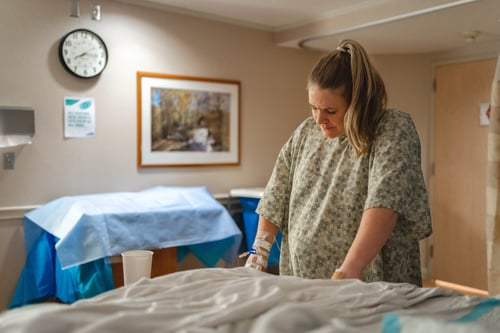What happens when your water breaks?
 During pregnancy, a baby is contained in a sack of amniotic fluid that helps them move and grow while protecting them from outside germs. For the majority of pregnancies, that amniotic sack breaks at some point during labor from the pressure of contractions. This is also known as “membrane rupture” or “water breaking.” However, in 8-10% of pregnancies, the water breaks before the start of labor. Birth professionals refer to this as Pre-labor Rupture of Membranes or PROM.
During pregnancy, a baby is contained in a sack of amniotic fluid that helps them move and grow while protecting them from outside germs. For the majority of pregnancies, that amniotic sack breaks at some point during labor from the pressure of contractions. This is also known as “membrane rupture” or “water breaking.” However, in 8-10% of pregnancies, the water breaks before the start of labor. Birth professionals refer to this as Pre-labor Rupture of Membranes or PROM.
When your water breaks, sometimes you feel an internal “pop” sensation or a sudden gush of fluid, while for some it is more of a trickle. It can be both exciting and scary to have your water break, especially if it happens when you’re least expecting it!
So what should you do if your water breaks before the start of contractions? First off, note the time of your water breaking and check for color and odor so you can report this information to your doctor or midwife. Amniotic fluid should be clear or slightly tinted beige without a strong odor. Sometimes there are a few streaks of blood, indicating that your cervix is changing. If the color is greenish, there is a bad odor, or substantial bleeding, you should notify your care provider immediately.
You will decide with your doctor or midwife whether to opt for induction right away (starting labor with medication) or expectant management (the wait and see approach). This decision-making process should factor in the risks and benefits of both options, but expectant management is more likely to be offered for low risk pregnancies.
Low-risk means:
- you are at least 37 weeks with a single head-down baby
- negative for Group B Strep
- your amniotic fluid is clear
- you have no signs of fever
- baby’s heartbeat sounds normal
Studies show that 77-95% of people begin labor on their own within 24 hours of their water breaking, but induction may be indicated if there are any risk factors or if you’re in the small percentage of people who are still waiting for labor after 24 hours. It is important to note that vaginal exams increase the risk for infection so they should be kept to a minimum.
Whether you wait for labor to begin or start an induction, you will meet your baby soon!
Sources:
Prelabor Rupture of Membranes | ACOG
Evidence on: Induction when your Water Breaks at Term (evidencebasedbirth.com) 2021_PS-Prelabor-rupture-of-membranes (midwife.org)


